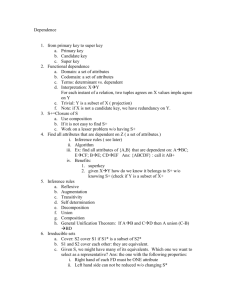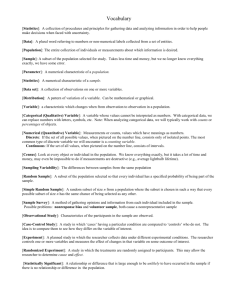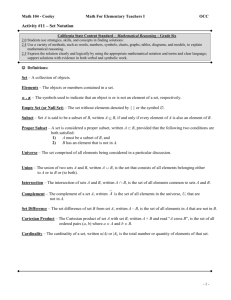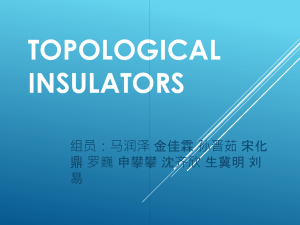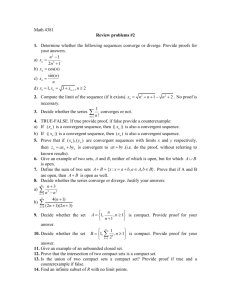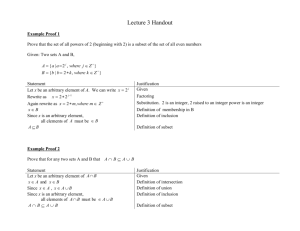3- Main Result
advertisement
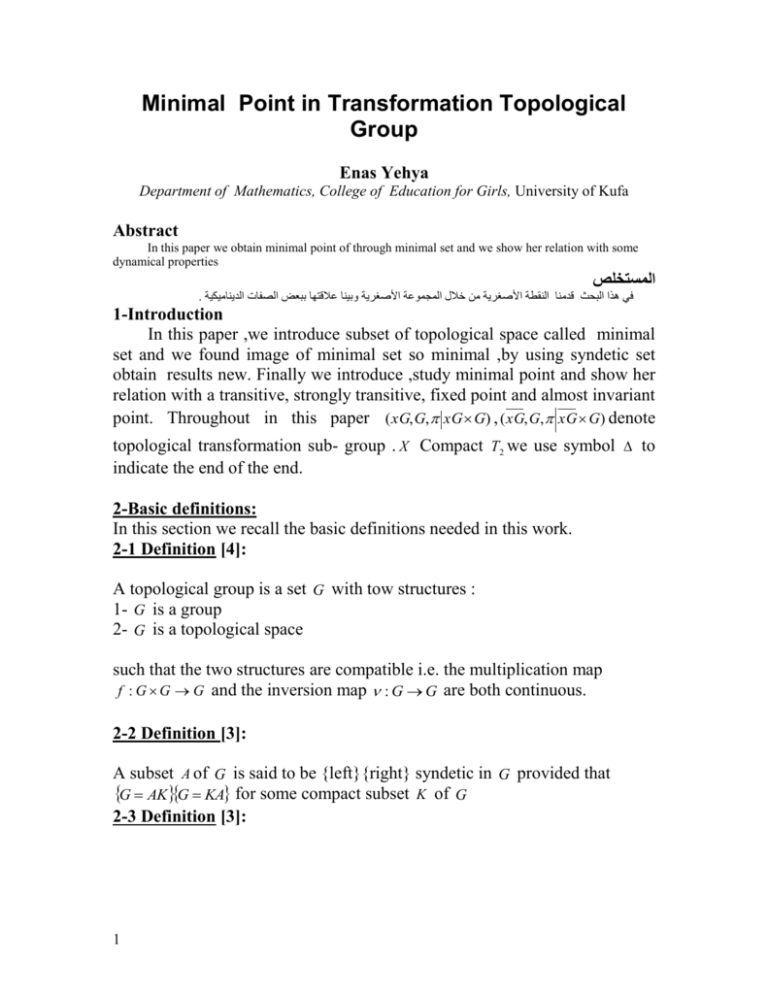
Minimal Point in Transformation Topological
Group
Enas Yehya
Department of Mathematics, College of Education for Girls, University of Kufa
Abstract
In this paper we obtain minimal point of through minimal set and we show her relation with some
dynamical properties
المستخلص
. في هذا البحث قدمنا النقطة األصغرية من خالل المجموعة األصغرية وبينا عالقتها ببعض الصفات الديناميكية
1-Introduction
In this paper ,we introduce subset of topological space called minimal
set and we found image of minimal set so minimal ,by using syndetic set
obtain results new. Finally we introduce ,study minimal point and show her
relation with a transitive, strongly transitive, fixed point and almost invariant
point. Throughout in this paper ( xG, G, xG G) , ( xG, G, xG G) denote
topological transformation sub- group . X Compact T2 we use symbol to
indicate the end of the end.
2-Basic definitions:
In this section we recall the basic definitions needed in this work.
2-1 Definition [4]:
A topological group is a set G with tow structures :
1- G is a group
2- G is a topological space
such that the two structures are compatible i.e. the multiplication map
f : G G G and the inversion map : G G are both continuous.
2-2 Definition [3]:
A subset A of G is said to be {left}{right} syndetic in G provided that
G AKG KA for some compact subset K of G
2-3 Definition [3]:
1
A right topological transformation group is define to be an ordered triple
( X , G , ) consisting of a topological space X , topological group G and
mapping : X G X such that :
1- (Identity axiom) ( x, e) x( x X ) where is the identity element of G .
2-( Homomorphism axiom) (( x, t ) , s) ( x, ts) ( x X ; t , s G) .
3- (Continuity axiom) is continuous .
If ( X , G , ) transformation group then X G is called the phase
spacegroupprojectionof ( X , G, ) .
If G Z called right topological transformation group with discrete flow.
2-4 Definition:
If g G ,then the t- transition of ( X , G , ) denoted t is the mapping
g : X X such that x g ( x, g ) xg (x X) .The transition group of
( X , G , ) is the set T g : g G.The transition projection of ( X , G , ) is the
mapping : G T such that g g (g G) .
If x X ,then the x- motion of ( X , G , ) denoted x is the mapping
x : G X such that g x ( x, g ) xg (g G) .The motion space of
( X , G , ) is the set M x : x X .The motion projection of ( X , G , ) is the
mapping : X M such that x x ( x X ) .
2-5 Definition [1]:
Let ( X , G, ) be a topological transformation group is said to be fixed at
x and the point x is said to be fixed under G provided that xG x that is ,the
period of G at x is G .
2-6 Definition:
2
Let ( X , G, ) be a topological transformation group, A X is called
invariant set under G if AG A
2-7 Definition [2 ]:
Let ( X , G , ) be a topological transformation group and x X .Then the set
xG ( x, g ) : g G is called the orbit of x and the set xG the orbit closure
of x.
2-8 Examples
1-The orbit of x under G is invariant subset of X .
2- The orbit closure of x under G is closed invariant subset of X .
2-9 Definition:
1-A point x X is called transitive point if xG X .
2-A point x X is called strongly transitive point if xG X .
2-10 Remark:
A x X is fixed point if and only if xG fixed orbit .
2-11 Definition [1]:
Let x X .The ( X , G, ) be a topological transformation group is said to be
almost invariant at x and the point x is said to be almost invariant under G
provided that if U is a invariant neighborhood of x then there exists a
syndetic subset A of G such that xA U .
2-12 Remark :
3
1- If A X is invariant , G a belain then Ag invariant set.
2- If A X is invariant under G and P subgroup of G then A is invariant
under P .
3- If A is dense subset of X then A is invariant set.
2-13 Theorem:
If A X is invariant set and y A then yG A .
Proof:
Let A subset of X and y A .Then ( y, G ) ( A, G ) and A is an invariant
set imply yG A , since y AG for each g G there exist a A such that
y ag , a yg 1 ( y, G) so ( A, G ) ( y, GG) , ( A, G ) ( y, G )
, A yG therefore yG A .
2-14 Theorem:
If A B ,A is invariant and x A fixed point then B is invariant set.
Proof: Let A be a subset of B and x A .Then AG BG and A is invariant
set imply A BG and so x BG .There exist b B, g 1 G such that
x bg 1 , b xg for each g G .Since x fixed point b x and so b A
.Therefore B A , A B .Thus
B is invariant.
2-15 Theorem:
If P compact subset of G then xP is invariant subset of X.
Proof: Let xP a subset of X and x xP ,since xG is least invariant set of X
which contains the point x , xP xG .Since x xP there exist g 1 P G
such that x xg 1 , xg x for each g G , xgp xp for some p P xGP xP
,since P compact subset of G , xG xP , xG xP thus xP is invariant subset
of X
4
2-16 Corollaries:
Let ( X , G , ) be a topological transformation group
1- If x xG then x is invariant set.
2- x Fr (A) then Fr (A) is invariant set.
2-17 Definition:
Let ( X , G , ) be a topological transformation group is said to be strongly free
if
there exist x X with xg x, then g e for each g G.
2-18 Theorem:
If A X is closed invariant set then Fr ( A) xG .
Proof: Let A be invariant subset of X ,and x A .Then xG A by (2-13)
,since A closed set , Fr ( ( A) A so Fr ( A) xG ,hence Fr ( A) xG
.Therefore Fr ( A) xG .
3- Main Result
Before , we state the main result of this paper, we introduce the following
definitions.
3-1 Definition [2] [5]:
Let ( X , G , ) be a topological transformation group a set M X is called
minimal set if it is non-empty ,closed and invariant and dose not have any
proper subset with these three properties.
The ( X , G , ) topological transformation group is called a minimal if X is
minimal.
5
3-2 Examples
1. If M X minimal set and X compact then M compact set.
2. If M X minimal set then Mg minimal set.
3-3 Theorem :
If a set M X is minimal then G strongly free for each g G .
Proof. :Let M be minimal subset of X .Moreover M is invariant set implies
MG M for each g G there exist x M X such that xg x, x g x e
hence g e , therefore G is strongly effective .
3-4 Theorem :
If xG is a minimal subset of X , x X then xG x .
Proof: Let x be arbitrary non-empty subset of X , and x x since xG is
least invariant closed subset of X which contains the point x ,i.e. x xG
Moreover , x is invariant set by (2-16 number 1) .Since x X .Then by
hypothesis x closed set since xG is a minimal set then x xG .
3-5 Theorem :
Let ( X , G , ) be a topological transformation group, M minimal set then
there exists compact subset K of G with MK M .
Proof: Let M be a minimal subset of X set then by hypothesis MG M
.Since G be a syndetic set, then there exist compact subset K of G such
that GK G with MGK MG thus MK M .
3-6 Corollaries:
Let ( X , G , ) be a topological transformation group, M minimal set then:
1- there exists syndetic subset A of G with MA M .
2- If U is a invariant neighborhood of x , xG X then xG U .
6
3-7 Theorem :
If M X is minimal set, Fr (M ) compact set then Fr (M ) is minimal set.
Proof.: Let Fr (M ) is non-empty and subset of X, Then Fr (M ) is an invariant
set
(2-16 number 2). Moreover , Fr (M ) compact set and X space T2 , Fr (M )
closed set. Since M closed set Fr (M ) M and M non-empty, closed and
invariant and dose not have any proper subset with these three properties.
Then Fr (M ) M hence Fr (M ) is minimal set.
4- Minimal point
In this section we give a minimal point
4-1 Definition:
Let ( X , G , ) be a topological transformation group is called a point x
minimal point if orbit closure of x X is a minimal set.
4-2 Theorem :
If x X minimal point, y xG then y minimal point.
Proof. Let x X and y xG then yG xG and so yG xG sine x minimal
point then xG it is non-empty, closed and invariant set and dose not have
proper subset with these three properties and therefore yG xG thus y
minimal point .
4-3Theorem:
7
Let ( X , G , ) be a topological transformation group, x minimal point, M
dense subset of X then x fixed point .
Proof: Let M be arbitrary non-empty dense subset of X , such that M X
where X be an invariant .then by hypothesis M be an invariant closed
set.Therefore all points of X are M ,since xG is least invariant closed
subset of X which contains the point x, M xG and x minimal point imply
M xG ,since x M .Therefore xG M by( 2-13) i.e. xG xG so xG x by
(3-4) x thus fixed point .
4-4Theorem:
Let ( X , G , ) be a topological transformation group, then x almost invariant
if and only if x minimal point.
Proof: Let x almost invariant point then for each an invariant neighborhood
U of x There exist syndetic subset A of G such that xA U .Since A
syndetic subset of G . There exists compact subset K of G such that
AK G, xAK UK so xG UK , xGG UKG and G syndetic imply xGG UG
and both xG, U invariant set imply xG U .Moreover xG U by (3-6
number 2) .Since y xG , yG U by
(2-13) therefore xG yG .Since xG is least invariant subset of X which
contains the point x ,then x yG .Therefore yG xG , xG minimal set thus x
minimal point .
Conversely let U invariant neighborhood of x .Since x minimal point, x
fixed point by (4-3) and G syndetic set Therefore xG U , x almost
invariant.
4-5 Remark :
1- If X be minimal then x X transitive point.
2- If x X minimal point then x transitive point in ( xG, G, xG G) .
4-6 Theorem :
8
If x strongly transitive point , then x minimal point.
Proof : Let xG non-empty , invariant set subset of X .Since x strongly
transitive point then xG X , xG closed set dose not have any proper subset
with these three properties thus xG minimal set .Therefore x minimal point.
.
References
[1] Bota,C. A bout the invariant and minimal sets of a dynamical system
on a
topological space , Timisoara Romania ,Vol.XXXIX,2001,
September18-22,2001.
[2] Ellis, R. Lectures on Topological Dynamics, W. A. Benjamin, INC.
NewYork (1969).
[3] Gottschalk, W. H and Hedlund,G.A. Topological Dynamics,
American Mathematical Society (1955).
[4] Higgins, P. J, An Introduction to Topological Groups,Cambridge
University Press(1974).
[5] Jezierski, J and Marzantowicz, W, Homotopy Methods in
Topological Fixed and Periodic Point Theory, Springer
Published(2006).
9
10

